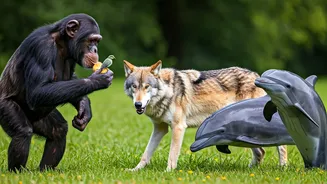Ants: The Termite Hunters
These insects are famous for their remarkable size and their dietary preference for termites. They not only hunt termites but also demonstrate a form of
altruism. After battles, these ants carry their injured comrades back from termite nests to ensure their survival. This behavior highlights the intricate social structures within ant colonies, emphasizing cooperation and care for the injured. Their actions are a testament to the complex dynamics that can be found in insect societies.
Dolphins: Pods of Kindness
These highly social marine mammals travel in pods and communicate via clicks and whistles, with specific signature calls for individual recognition. Dolphins have been observed supporting injured companions at the surface of the water, providing them with access to air to breathe. This behavior shows a depth of empathy and care, demonstrating their social bonds. The use of unique signature calls also underlines a complex communication system within these pods, that enhances the collaborative behaviors of dolphins.
Humpback Whales: Defenders of Others
These huge ocean migrants, known for their long, white-edged flippers, have been filmed intervening to disrupt attacks by orcas on seals or gray whale calves. Even when the threatened young are not their own, these whales display protective behavior. The humpback whale’s intervention highlights interspecies compassion, showcasing a willingness to protect others, even at personal risk. Their actions underline a complex understanding of the ocean's ecosystem, and their role within it.
Vampire Bats: Blood Donors
These nocturnal flying mammals often share blood meals with roost-mates that have failed to feed, a practice known as food-sharing. This 'donation' is done to maintain social bonds and safeguard the survival of their fellow members. This reciprocal altruism underscores the social dynamics of vampire bats and the importance of cooperation for survival. The willingness to share resources, especially during a food shortage, strengthens social connections within the colony.
Meerkats: Family Helpers
These small desert-dwelling carnivores live in family groups in the African savanna. Some meerkats stand guard, keeping watch, while others mind the pups underground, and the rest forage for food. They rotate these roles to enable everyone to eat, which shows a sophisticated system of division of labor. This coordinated behavior demonstrates their social structure, which ensures the survival of all members of the family group. This also underscores the cooperation in a challenging environment.
Penguins: Huddling for Warmth
On the coldest Antarctic nights, adult members of this bird species gather with chicks in large crèches. They take turns moving from the windy edge to the warmer center. This organized huddling helps young penguins survive, ensuring they are protected until their parents return from the sea. Their actions illustrate an instinctual adaptation that facilitates survival in extreme conditions. The shared warmth is a crucial part of the penguin's strategy for enduring freezing temperatures.






